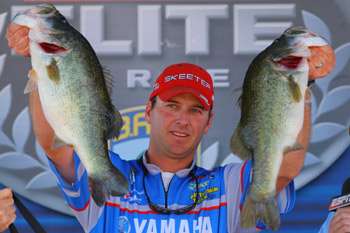
Amistad offered up more weight than many predicted she would. The top three places went to anglers that averaged about 5 pounds per bass, and those anglers pointed to where they fished as the reason for their success.
1st place:
Todd Faircloth
(76 pounds, 15 ounces)
"I targeted flats in the main lake and in the backs of spawning bays," the Texas resident says. "The best places were those with submerged trees near or on points. The very best spots had isolated trees on them."
Faircloth found his fish during practice with a Sebile Magic Swimmer. He worked the jointed, lipless swimbait fast in likely looking areas, creating a wake along the water's surface.
"That was an important part of my success. Not all the flats held fish, only some of them. If the bass were there they'd move up and chase the Magic Swimmer. They weren't biting it but at least I knew they were there and I could mark the spot. Then, during competition I went back to those same spots, slowed down, and caught three good bags."
Most of his fish were caught on a 6 inch Senko — watermelon, black with green flake — that he allowed to fall slowly to the bottom. But his biggest bass, and a number of other quality keepers, bit a soft plastic swimbait worked slowly through those areas in the 5-6 foot depth range.
Faircloth fished his Senko when the water was slicked over and the wind calm. He threw the swimbait when there was a good chop on the water.
"I caught most of my last day fish from one tree. It was a good spot but I think the real key to my win was practice. It wasn't great but I was able to locate bass holding areas that became important to me later in the tournament. Then I was able to change as the wind changed and catch what was available to me.
"It might sound obvious but you've got to fish where the fish are. Finding them — not catching them — in practice was key. After that I was able to change tactics as conditions changed."
2nd place:
Clark Reehm
(76 pounds, 3 ounces)
Clark Reehm, Elite Series rookie and a Top 10, 2008 Classic finisher after qualifying for the event through the Opens, secured his second place finish with a spot he found last September while fishing Amistad.
"It was a point near a channel swing, with bushes on top, big hardwood trees at the bottom, grass on the front end of it, and a spawning flat in the back" he says. "The top of the point was in 20 feet of water but the sides dropped sharply to 40 feet. It had everything I wanted. It was absolutely perfect."
Reehm tricked his bass with a big, Carolina rigged red worm — fished slow — and a tilapia colored Tru-Tungsten Tru-Life Swimbait. "The Carolina rig was generic. I used a big worm, a heavy weight and a big worm hook. That's all, nothing special. I fished the swimbait fairly fast. I was able to keep it down by adding three tungsten balls to it.
"But the reason I caught so many bass wasn't my bait, it was my spot. The bass were all around it. I worked the area carefully every day and caught fish every day there. It produced nine bass over 5 pounds for me during the tournament, and one more for my co-angler. That's a lot of big fish in a short period of time.
"Some of them were prespawn, others postspawn. It was a highway for them to go to and from their spawning areas. I was able to catch them moving in both directions. It was a classic spring type place, the kind you dream about."
3rd place:
Kevin Short
(75 pounds, 10 ounces)
"My area was the biggest thing," says Short. "I fished a series of 12-15 points, one after the other, near channels that entered little, flat spawning pockets. The bass were spawning on top of the points, as well as back on the flats, and I was able to target fish moving in both directions."
He continues on to explain that this is a classic bass fishing strategy for the middle of the spawn when water temperatures are in the middle 60 to low 70 degree range.
"Not all bass spawn at the same time. Some of them will be traveling to the spawn, others will be on the spawn, and still others will be leaving their spawn. If you can find areas like this you can catch a bunch of bass, and they'll probably be good year after year, too."
The first day and a half most of his fish came on a 5/8 ounce Jewel Football Jig with a Zoom Super Speed Craw — "I wanted the big flippers" — in brown. He dyed the tail chartreuse.
But as the tournament went along the bite slowed and he switched to a Zoom Old Monster Worm — thick bodied with a ribbon tail — in watermelon candy with a chartreuse tail.
"I think those colors, especially with the chartreuse tail, looked like a bluegill and that's what the big ones were feeding on. My best bites were with the worm rigged Texas style. How else would I rig it? We were in Texas, man!"
